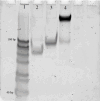Differentiation of Bacillus cereus Species Based on Detected Unamplified Bacterial 16S rRNA by DNA Nanomachine
- PMID: 40395839
- PMCID: PMC12086345
- DOI: 10.21769/BioProtoc.5243
Differentiation of Bacillus cereus Species Based on Detected Unamplified Bacterial 16S rRNA by DNA Nanomachine
Abstract
Traditional approaches for the detection and differentiation of Bacillus cereus group species often face challenges due to the complexity of genetic discrimination between species. In this protocol, we propose a simple and straightforward assay based on the detected unamplified bacterial 16S rRNA by DNA nanomachine (DNM). The assay incorporates a universal fluorescent reporter and four DNA binding fragments, three of which are responsible for "opening up" the folded rRNA while the fourth strand is responsible for detecting single nucleotide variation (SNV) with high selectivity. The binding of the DNM to 16S rRNA results in the formation of the 10-23 DNAzyme catalytic core that cleaves the fluorescent reporter and produces a signal, which is amplified over time due to catalytic turnover. The developed biplex assay enables the detection of B. thuringiensis 16S rRNA and B. mycoides at fluorescein and Cy5 channels, respectively. The protocol offers two detection options: one utilizing extracted total RNA and the other involving crude cell lysate. The latter enables a fast and straightforward detection after 1.5 h with a hands-on time of ~15 min. The new protocol may simplify the analysis of biological RNA samples and might be useful for environmental monitoring as a simple and inexpensive alternative to amplification-based nucleic acid analysis. Key features • A sensitive and selective amplification-free biplex assay for differentiating Bacillus thuringiensis and Bacillus mycoides based on the 16S rRNA. • A simple and inexpensive assay alternative to amplification-based nucleic acid analysis, useful in environmental monitoring applications. • Adaptable for other challenging bacterial strains beyond Bacillus cereus species.
Keywords: 10-23 DNAzyme; 16S rRNA; Amplification-free detection; B. cereus; Detection of folded RNA; Single nucleotide selectivity.
©Copyright : © 2025 The Authors; This is an open access article under the CC BY license.
Conflict of interest statement
Competing interestsThe authors declare no competing financial interests.
Figures



Similar articles
-
DNA Nanomachine (DNM) Biplex Assay for Differentiating Bacillus cereus Species.Int J Mol Sci. 2023 Feb 24;24(5):4473. doi: 10.3390/ijms24054473. Int J Mol Sci. 2023. PMID: 36901903 Free PMC article.
-
Cloning and nucleotide sequence analysis of gyrB of Bacillus cereus, B. thuringiensis, B. mycoides, and B. anthracis and their application to the detection of B. cereus in rice.Appl Environ Microbiol. 1999 Apr;65(4):1483-90. doi: 10.1128/AEM.65.4.1483-1490.1999. Appl Environ Microbiol. 1999. PMID: 10103241 Free PMC article.
-
Identification and Analysis of Informative Single Nucleotide Polymorphisms in 16S rRNA Gene Sequences of the Bacillus cereus Group.J Clin Microbiol. 2016 Nov;54(11):2749-2756. doi: 10.1128/JCM.01267-16. Epub 2016 Aug 31. J Clin Microbiol. 2016. PMID: 27582514 Free PMC article.
-
Use of 16S rRNA, 23S rRNA, and gyrB gene sequence analysis to determine phylogenetic relationships of Bacillus cereus group microorganisms.J Clin Microbiol. 2004 Aug;42(8):3711-30. doi: 10.1128/JCM.42.8.3711-3730.2004. J Clin Microbiol. 2004. PMID: 15297521 Free PMC article.
-
Discrimination between Bacillus cereus and Bacillus thuringiensis using specific DNA probes based on variable regions of 16S rRNA.FEMS Microbiol Lett. 1997 Jan 1;146(1):47-51. doi: 10.1111/j.1574-6968.1997.tb10169.x. FEMS Microbiol Lett. 1997. PMID: 8997705
References
-
- Johler S., Kalbhenn E. M., Heini N., Brodmann P., Gautsch S., Bağcioğlu M., Contzen M., Stephan R. and Ehling-Schulz M.(2018). Enterotoxin Production of Bacillus thuringiensis Isolates From Biopesticides, Foods, and Outbreaks. Front Microbiol. 9: e01915. 10.3389/fmicb.2018 .01915 - DOI - PMC - PubMed
LinkOut - more resources
Full Text Sources

